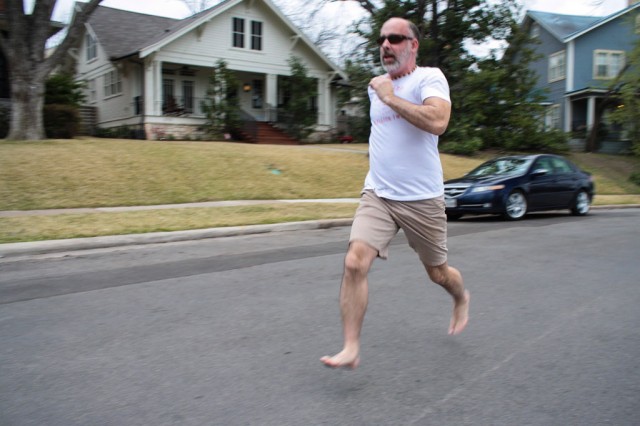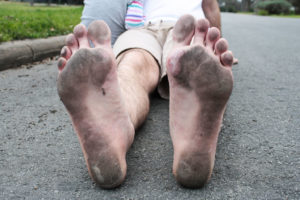Just Un-Do It? Some Austin Runners Take to the Trail Sans Shoes

Andrew Palmore is out for a run in Austin’s Hyde Park neighborhood. The barefoot running movement has become so popular that enthusiasts such as Palmore have started participating in marathons without shoes. Photos by Olivia Starich/Reporting Texas
By Rachel Thompson
For Reporting Texas
One early summer morning in 2007, Jim Nicar headed to the track at Austin High School, leaving his running shoes untied inside his home.
He wouldn’t need them.
A year earlier, Nicar had placed himself on a running hiatus due to painful plantar fasciitis, an inflammation of tissue in the lower foot. He scoured the Internet to find a way to return to running and came across a website called BarefootRunning.com. It was maintained by marathoner Ken Bob of Huntington Beach, Calif., who advocated for running without shoes and had been doing so for nearly 10 years.
Nicar continued to read about the practice and discovered more online forums, where other runners shared their positive experiences. Still, he was skeptical. But then he looked more closely at the runners who were posting: a lawyer from Seattle, a high school basketball coach from Kansas City, a small group of runners from Harvard. Many were educated professionals.
He decided to try it. After a few short runs on the Town Lake Trail with shoes to ease back into the sport he’d once loved, Nicar stepped onto the Austin High track barefoot and felt the slight spring of it beneath his feet. Instead of striking the ground with his heels, he began landing mid-foot. Lighter, easier.
“By the end of that first lap, running suddenly became new again,” he said in an email.
It was a freeing experience soon to be undertaken by a small slice of the running community. In 2009, journalist Christopher McDougall published “Born To Run: A Hidden Tribe, Superathletes, and the Greatest Race the World Has Never Seen.” The book traces natural running practices to the Tarahumara Indians, a tribe in northwestern Mexico. The Tarahumara people could run for days on end, and they did it without the cushion and protection of modern footwear.
McDougall spent considerable time in Mexico trying to decipher what made the Tarahumara so physically capable, crediting their minimalist running practices in slim sandals or no shoes at all. As he searched for evidence of the benefits of running shoes and found none, he concluded that running barefoot allowed the body to position itself naturally and spare unnecessary injuries.
The pricey specialty shoes, he claimed, were causing more harm than good. Runners landed in unnatural positions as their feet hit the ground.
“For millions of years, humans ran without arch support, pronation control or gel-filled pods under their heels,” he states in the book.
Once the book was published, barefoot running manifested into a movement. Runners formed local groups, connected through online forums and simply ditched their shoes to test McDougall’s theory. The Barefoot Runners Society, an international barefoot and minimalist running club, was formed in 2009 and has active chapters in the United States and internationally.
Some companies were already catering to minimalist runners and saw sales spike. Targeting customers who embraced the barefoot idea but needed to ease into it, Vibram’s FiveFingers, a cross between a sock and a shoe, were designed to emulate the barefoot experience with a pocket for each toe. New Balance went ultra-light with the Minimus. Nike found its space in the market with the Nike Free.
But despite the scientific evidence McDougall presented in “Born to Run,” many began to argue that running with less-cushioned shoes or no shoes at all led to more injuries, not fewer.
Austin podiatrist Gary Prant was approached by many local runners who sought his opinion on the topic.
“I find that this phenomenon, while a boon to some runners, may invite injuries for others,” he wrote in a blog post.
Prant recommends runners ease into minimalist practice with caution. Most runners, he wrote, have to actually learn how to run barefoot. Evidence for or against running shoes, he wrote, is inconclusive.
Like many fitness trends, barefoot running has waxed and waned, peaking after “Born To Run” was published. Scientists still debate whether running barefoot prevents injury and whether running shoes cause more harm than good. Recently, maximalist shoes have gained popularity as some ultrarunners — those who far exceed marathon distances — claim the extra support feels better.
For others, barefoot running became not just a habit, but a way of life they hold onto even as the trend passed.
Like Nicar, Kyle-based teacher Andrew Palmore joined the Austin Barefoot Running Meetup group on Facebook, which has 172 members. Palmore read “Born To Run” and began jogging short distances in his neighborhood, then quickly eased into a three-mile loop.

Palmore’s feet after a run. Palmore has run many races barefoot, often resulting in blistered feet.
One year later, he ran the Austin Half-Marathon barefoot, finishing in just over two hours. The following year, in 2013, he ran a full marathon. After mile 20, his feet were blistered and sore, but he pressed on.
“The whole element of doing it barefoot motivated me,” he said. “I may not be the fastest, but I might be the fastest barefoot guy.”
Palmore offset occasional pain by adding rest days in between his runs. In January, he ran the Rogue Distance Festival 30K, fighting wet roads and near-freezing temperatures. After the race, he noticed a trail of blood trickling from his feet and onto the bathroom floor. For a week after the race, he crawled around his house, unable to walk.
Blistered feet weren’t enough to dissuade Palmore. Neither were the comments from friends and family to put on some shoes and save himself the agony.
“All I know,” he said, “is it feels pretty good to have your feet touch the ground.”